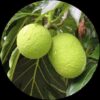- Empty cart.
- Continue Shopping
-34%
Sethapazham (Sugar-apple) Red
Original price was: ₹425.00.₹280.00Current price is: ₹280.00.
Genus : Annona
“Add a splash of vibrant red and tropical vibes to your garden with the Sethapazham (Sugar-Apple) Red plant. Indulge in the luscious and sweet fruit it bears.”
Sethapazham, also known as Red Sugar-apple or Annona reticulata, is a tropical fruit tree that belongs to the Annonaceae family. It is closely related to the Green Sugar-apple (Annona squamosa) but is characterized by its unique red coloration. Here is a more detailed description of the Sethapazham (Sugar-apple) Red plant:
Description:
- Size: The Sethapazham (Sugar-apple) Red tree is a small to medium-sized tree that usually grows to a height of 3-8 meters (10-26 feet), although some varieties may grow taller.
- Leaves: The leaves of the Sethapazham (Sugar-apple) Red plant are simple, alternate, and dark green in color. They are oval or elliptical in shape with a smooth margin and a glossy texture. The leaves are deciduous, meaning they shed their leaves during the dry season or in colder climates.
- Flowers: The flowers of the Sethapazham (Sugar-apple) Red plant are small and red or maroon in color. They are fragrant and usually appear singly or in clusters on the branches and trunk of the tree. The flowers are pollinated by insects, especially beetles and flies.
- Fruits: The fruit of the Sethapazham (Sugar-apple) Red plant is the highlight of the tree. It is a compound fruit made up of multiple segments or carpels, each containing a creamy, custard-like pulp with embedded black seeds. The fruit is usually heart-shaped or conical in appearance, with a scaly or knobby skin that is red or maroon in color when ripe.
- Bark: The bark of the Sethapazham (Sugar-apple) Red plant is smooth, light gray to brown in color, and may have shallow furrows or cracks as the tree ages.
Cultivation:
- Climate: The Sethapazham (Sugar-apple) Red plant thrives in tropical and subtropical climates, where temperatures do not drop below freezing. It prefers well-drained, loamy soils and can tolerate a range of soil types, from sandy to clayey.
- Propagation: The Sethapazham (Sugar-apple) Red plant can be propagated from seeds or cuttings. Seeds are typically extracted from ripe fruits and sown in well-draining soil. Germination can take a few weeks to a few months. Cuttings can be taken from mature trees and rooted in a rooting medium.
- Care: The Sethapazham (Sugar-apple) Red plant requires regular watering, especially during dry periods, and benefits from occasional fertilization. Pruning can be done to shape the tree and remove dead or diseased branches. It is a relatively low-maintenance tree once established.
- Harvesting: The fruits of the Sethapazham (Sugar-apple) Red plant are usually harvested when they are fully ripe and the skin turns red or maroon. They are typically handpicked from the tree, as they do not ripen well after being harvested. The fruit is best consumed fresh, and the seeds are usually removed before eating due to their toxicity.
Uses:
- Culinary: The fruit of the Sethapazham (Sugar-apple) Red plant is highly prized for its sweet, custard-like pulp, which is eaten fresh. The pulp can be scooped out and eaten directly, or used in smoothies, desserts, ice creams, or other culinary preparations. The flavor of the fruit is often described as a mix of flavors, including sweet, tangy, and creamy, with hints of pineapple, banana, and vanilla.
- Medicinal: The Sethapazham (Sugar-apple) Red plant has been














Reviews
There are no reviews yet.